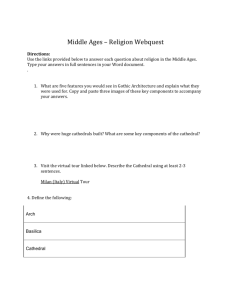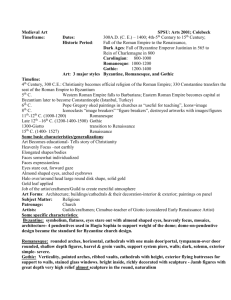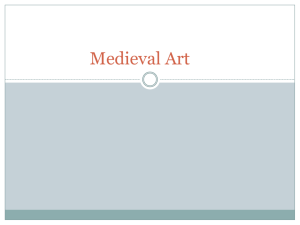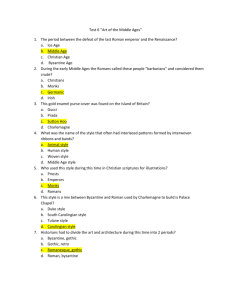Medieval_Style_-_Presentation - techtheatre
advertisement
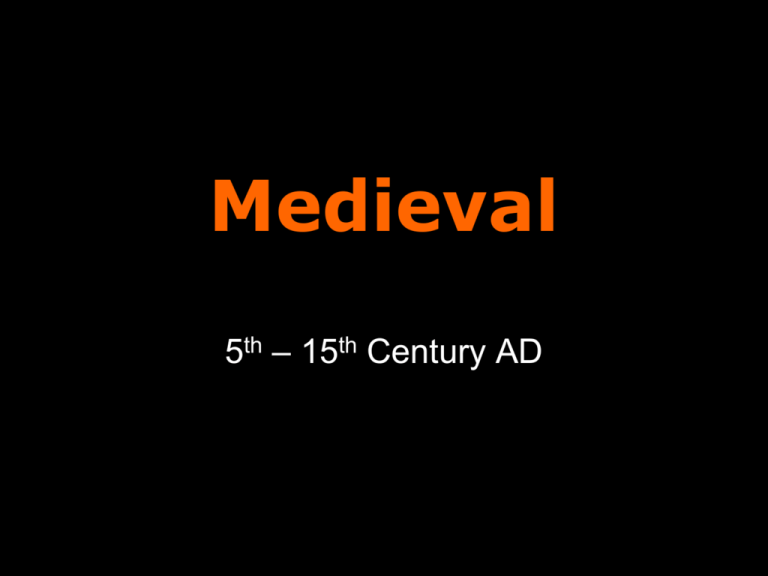
Medieval 5th – 15th Century AD 1 Chronology Byzantine and Early Medieval A.D. 330 Constantinople becomes capital of the Eastern Empire 6th Century Secrets of the process of silk production smuggled back to Byzantium from China 527-564 Reign of Justinian Early 7th century The founding of Islam by Mohammed 800 Charlemagne, son of Pepin, crowned Emperor of the Romans by the pope 1066 William the Conqueror, a Norman, invades England and becomes King 1095 Pope Urban declares the First Crusade mid-11th to mid-12th centuries Romanesque architecture styles predominate in Europe after 1150 Gothic styles develop in architecture 1271-72 The Ninth and last crusade 1273 First Hapsburg emperor of German states 1453 Constantinople conquered by Ottoman Turks BYZANTINE EMPIRE C.330-1453 Historical Background • Between 400-900, styles of the Byzantine Empire influenced all of Europe • Byzantium was the cultural center of the period • The remainder of Europe was illiterate, literacy was barely kept alive in the monasteries • After 10th century, Europe began an economic recovery and influences became less important • Constantinople was originally a Greek city selected by Constantine to be the ester capitol of the Roman Empire • Located at the entrance to the Black Sea it was ideal for trade and protected by the Balkan Mountains •It was the cultural crossroads of the East and West • Throughout history Byzantium as constantly at war (Persian, Arabs, Bulgers, Turks…) • Eventually it was sacked and destroyed by the Turks in 1453 •Fortunately many artifacts were stolen and brought to foreign lands. Much of the evidence we have of this culture comes from these artifacts. Government • Head of Byzantine state was the Emperor • He could make any law he wished, and ruled the Eastern church • The Emperor ruled with the Empress • Landed nobility made up an important element of economic life and government • Aristocracy was one of WEALTH not BLOODLINE. Hard work could pay off! Ideals: • Education was considered very important • Place of women in society was rather advanced • Empresses could rule alone or together with the Emperor • Slaves were both foreign and captive • Writings and works of art were consciously preserved • Christ - the State – Afterlife • Dramatic Action is a tableau and the Proscenium is formed Fabric Production: • 4th to 6th century wool and linen were the predominant fabrics • 6th century silk production began • Byzantines produced silk for all of the Western world • Complex woven patterns were achieved EARLY MIDDLE AGES (Early Gothic) 10th-13th Centuries Historical Background Between 400-900, styles of the Byzantine Empire influenced all of Europe GOVERNMENT • Feudal system developed out of the need for protection as the empire collapsed under the attacks of the Vikings, Magyars, and Saracens • Central government vanished, law and order disappeared • Chiefs of tribes assembled their warriors in war bands….these warriors became the armored knights on horseback • It took years of training and special equipment to become a skilled knight, thus they became and elite “professional” fighters • Knights lived on the lords land and served as protector • Serfs worked the land of the lord • Serfs lost their freedom when given in exchange for protection from the lord • Law and order existed on a “local” level • Feudal lords and knights built castles on their lands to serve as places of protection. • Castles also served as homes • They were cold, damp, dark and very windy • The German Dynasties, Anglo-Saxons, Norman Britain and France all have their own unique rulers and lineage The Crusades: • Pope Urban II, launched the first of seven Crusades against the Moslems • Intended to free the holy place of Christendom from the Moslems • Motivations for crusades varied from religious fervor to outright mercenary designs to acquire wealth and power • By the end of the crusades many new products and processes had been imported to Europe • Printing patterns on textiles • Foods, spices, drugs • Works of art • Fabrics (muslin, silk damask and cotton) Medieval Castles and Court • Feudal lord and family had private quarters • Large fireplace provided heat • Furnishing simple and not comfortable • Luxury items were carpets, wall hangings and cushions (from the far East) • Wealthy merchants and trades people reside in towns Fabric Production • Women did spinning and fiber preparation, men did weaving • Dyeing was a specialized craft • Production moved to towns from rural areas • Horizontal loom was invented Chronology Late Medieval 1300’s Introduction of gunpowder and cannon to warfare 1337-1453 Hundred Year War between France and England 1348 First appearance of the plague in Europe (1/3 of population killed) 1386-1400 The Canterbury Tales by Chaucer c.1416 Portugal initiates exploration of the west coat of Africa 1453 Ottoman Turks conquer Constantinople 1454 First record of printing with moveable type in Europe 1492 Columbus reaches American Late Middle Ages (Late Gothic) 1300-1500 • Medieval monarch centralize government, and power of nobles and knights decline • Feudalism begins to wane – Kings found new sources of revenue by taxing cities and towns – New income allowed them to hire knights and peasants • • • Towns lost independence, but central government gains power Kings had to protect cities because they were the source of their income Cities become more capitalistic – New trades are established (bankers, investing, mining…) – Increase in the production of consumer goods, and the European economy adopted the use of money over barter. • Peasants now rent land in place of trading services – Peasants included: day laborers, millers, bakers, cattle dealers, domestic servants • Increase in city population – Poor harvest and cold weather lead to famine – Population weakened by famine was susceptible to disease (The Black Death) • Society was made up of Nobility, bourgeoisie and peasant Medieval Architecture Byzantine and Romanesque 10 Basilica of Maxentius (Reconstruction): the typical Roman configuration for the basilica was the rectangle. The plan shows a central axis. Nave: Center Aisle Christian Basilica: one entered through a forecourt or atrium. The ceilings in these early churches were of open timberwork construction with recessed coffers. Usually oriented East. Narthex: porch Transept: Crossed the end of the nave (Latin cross) Parting of Lot and Abraham Note: Perspective in reverse…Classicism (reinterpreted) into an abstract style suited to the spiritual goals of the church. Church of Santa Maria Maggiore (432): confirmed the practicality and adaptability of the basilica plan with arched clerestory windows above. The mosaic technique uses hundreds of small glass and marble tiles, or tesserae, set close together in mortar. Christian burial sites gradually moved to an underground vault, or crypt, below the floor of the basilica. Mausoleum of Galla Placidia (425-426): design of early churches exhibited a rough simplicity of the exposed stone of the exterior. Interiors, by contrast, were richly decorated and sheathed in brilliant mosaics. Blind Arcading: ornamental arches with no supporting function Central Plan Church: based on a circle inscribed in a square, or, like in the Galla Placidia, a cruciform (cross-shaped) plan, with each of the four arms of equal length. Pendentive Dome: supported on curved sections in between the four arches of the cross. The Hagia Sofia (Church of the Holy Wisdom) in Constantinople (532-537) The Byzantine Empire: as the Roman Empire declined…artistic and intellectual activity flourished in the east. The minarets were added later. The oldest (red brick) was added during the reign of Mehmed II (14511481) shortly after becoming a mosque. The slender stone minaret on the north was added during the reign of Selim I (1512-1520) by the prolific Ottoman architect Mimar Sinan, who also strengthened the mosque's walls with exterior buttresses. The two remaining minarets – which match each other, but neither of the two existing ones – were added during the reign of Murad III (1574-1595). The Hagia Sofia (Church of the Holy Wisdom) in Constantinople (532-537) Nave = Naos (central space). Note the design and emphasis of Christian ritual to direct the focus of the congregation upward toward Heaven… not eastward toward the altar in the apse. Note the windows as the base on the dome (highly unconventional). Indeed the first dome did collapse in 558, but was rebuilt to a higher pitch (survives today) Church of S. Vitale, Ravenna, Italy (526-547) Octagon Central Plan Ambulatory: an exterior passageway Emperor Justinian I and his Empress, Theodora (ruled 526-565) Also: Mosaic stories about the life of Christ are grouped in cycles, such as the "Incarnation" Cycle, and the "Passion" Cycle. Long Tunics and cloaks The Church was the repository of learning; the dissemination of knowledge was under its control. … Feudalism Structure … Charles the Great (Charlemagne): Granted the title of Emperor by the Church of Rome in 800. … The Book of Kells - Illuminated Manuscript (presented with Scandinavian animal interlace style) Expansion of Christian Monasteries The floorplan shows a central portal opening into the west end of the nave. The transept is as wide as the nave, forming a square at the crossing. The area of the nave east of the crossing, consisting of the choir (choir stalls) and the apse (altar) is referred to now as the sanctuary. Church of Sainte-Foy, France German and French Influence 10th - 12th Centuries “Romanesque” was coined in the 19th century to mean "in the Roman manner". • Stone Masonry (not concrete) • Rounded Arches • Barrel Vaults Tympanum [tim-puh-nuhm] - the semicircular panel above the door lintel. Christ is always shown larger than his disciples and the lay people. Church of Saint-Pierre, Moissac, Toulouse (1115-1130) < Basket Capital Pisa Cathedral (1063) Campanile [kam-puh-nee-lee] (1174): Baptistery not attached to Cathedral Interior has all the features of the early Christian basilicas, with its arcade of Corinthian columns and coffered ceiling. Byzantine Empire Clothing c. 300 to 1453 Wool and linen predominated until the 6th century. Silk was being produced by the Byzantines as early as the 6th century, and they continued to supply the Western world until the 9th century. Byzantine Tunic: a narrow, long-sleeved garment that was worn to the ankle Pallium [pal-ee-uhm] or lorum (lo΄rum): a long, narrow, heavily jeweled scarf or tabard. Medieval Architecture Early Gothic 26 The term "Gothic" was coined by the Italian artist and historian Giorgio Vasari in the 16th century. He attributed the style to the "Goths", Germanic northerners who, in his view, had destroyed the ancient classical civilizations that he and his contemporaries so admired. The Romanesque style has been characterized as primarily masculine in its imagery. It is a static style, full of rough grandeur. The Gothic style is sometimes characterized as being more feminine in its airy lightness. The figure of Eleanor of Aquitaine (1122-1204) dominated this period in France. At different times queen of both England and France, she was a powerful political force, and a devoted patron of the arts. From her court in Poitiers, she presided over an aristocratic life-style that was idealized in the literature of "Courtly Love". > Abbey of St. Denis, France (1135-40) Caen Cathedral, Saint-Etienne, Normandy (11-13th Century) Twin Bell Towers… accentuate the vertical. Chartres Church, France (1134-1220)… Referred to as the perfect embodiment of the Gothic spirit in glass and stone. • the pointed arch • ribbed groin vaulting • the flying buttress, a gracefully arched exterior support • the triforium, a mid-level passageway above the aisles that overlooks the nave through an arcade of columns. Early Middle Ages Clothing c. 300 to 1300 Linen and wool continued to be the primary textiles in use, although cotton was introduced as a luxury fabric from the Middle East during the invasions of the Moors into Spain in the 8th century. A preference for fur appeared, used in vests and cloak linings. Braies: Loose-fitting, diaper-like underwear - girdled at the waist Chainse [shens]: a type of gown that was made of washable material, probably cotton or linen Loose fitting, long tunics and palla-like mantles were consistently worn for several centuries after the fall of the Roman Empire. Women's costume shared many characteristics with men's dress from the 4th through the 10th centuries; Chemises, cotes and surcotes were unfitted and long. Mantle: loosly fitting outer garment. Worn over a tunic. Journade: boxy garment, pleats on arms During the 12th century, a radical change is seen in the cut and fit of men's and women's costume amongst the members of the court. The body was gradually revealed through the shaping and fitting of the tunic, and the garment resumed its full length. The tighter fit meant that the garment could not be slipped over the head, but required openings down the side seams that were laced shut. Medieval Architecture High and Late Gothic 35 Amiens Cathedral, France (1220-80)… High Gothic's supreme statement of elegance and verticality Quatrefoil: 4 intersecting circles Trefoil: a three-lobed design Lancet: pointed-arch clerestory windows Cathedral of Nôtre-Dame (East Façade:1163, West facade: 1215) The apse made use of the first true flying buttresses, although the present day supports were altered in the 19th century. Sainte-Chapelle, Paris, France (1243-48) Church of Saint-Maclou, Rouen, France (1436-1521) is an example of so-called Flamboyant style. "Façade" architecture : restlessness of form and excessive use of decoration Late Gothic Late Gothic < Exeter Cathedral (1328-48) is an example of the English Decorated Style or Perpendicular. Fan Vaulting Crenellated - or notched > Magdalen College at Oxford (1475-1500) is a good example of this rectilinear style Florence Cathedral, Italy (started 1296 but not completed until 1378) Late Gothic Nave was as tall, but 3 times as wide as Amiens. Form and proportion were more important than the infiltration of light into space. Late Middle Ages Clothing c. 1300 to 1500 Costume of the period emphasizes both vertical lines and the arabesque, serpentine curve found in the motifs of Gothic architecture. By this time the art of tailoring had advanced with the introduction of more complex patterning and curved seams of fitted garments. Tabard: male tunic was shortened to the crotch, putting emphasis on the torso and genital area, and reinforcing the message of sexual availability in a time when the plague was decimating the populations of Europe. Women's costume remained long, but revealed the body lines through an ever-increasing tight fit. A taste for luxury and personal individualization in dress fostered the development of fashion. Houppelande [hoop΄land]: large flamboyant robe with huge sleeves; belted at waist or rib cage. The sleeve edge was sometimes cut out in square or rounded scallops, a "dagged" edge. Chaperon with a roundlet hat (doughnut shape). Cote/cote-hardie [koat΄har΄de]: is thought to have been a variant of the surcote or outer tunic. Low, round neckline and sleeves ending at the elbow. Jerkin: an outer garment. (It gets shorter and shorter until it is called a doublet) Elaborate court dress Couple courting Doublet: originally a padded tunic worn under armor, emerged as a long-sleeved jacket cut to fit the torso closely, and laced closed down the front. Pourpointe [pour-pawnt΄]: another name for a doublet. Closed down the front with laces, also had four strings sewn to the underside for hose to attach Mantel: large capes Surcote: outer layer (outer tunic). Could be worn with or without sleeves. Cote: Innter layer (tunic) Kirtle: short, mid-thigh length undergown with round neck, tight fitting sleeves, floor or longer in lengths Fitted through the waist and wider through the skirt (high officials or elders wore longer) Sideless Gown (over Kirtle) Parti-colored Hose bliaut [blee΄o]: an elaborate closely fitted garment made of silk, satin, or velvet. Decorated with gold thread and precious stones Skirt and bodice sewn together (cut on the bias) Wimple: a fine white linen or silk scarf that covered the neck, the center placed under the chin and each end pulled up and fastened above the ear or at the temple (generally worn in combination with a veil) Poulaine: Pointed shoes Double Henin (Butterfly Hat) Chaperone with Liripipe [lir-eepahyp]: hat with a long point Henin (Single Cone) and Sugar Loaf Hat Heart-Shaped Hat Fitchet: (modern pockets) to be worn with outdoor garments so wearer could put hands in for warmth or reach a purse hanging from a belt. Furniture 53 Byzantine Furniture and Decoration General Characteristics: • use of anti-naturalistic forms in favor of a new hieratic or "priestly" style. • decoration based on organic forms, characterized by flowing lines and swirling shapes, known as arabesque line. • stylized animal motifs - griffins, lions, serpents, and vegetal motifs •an anti-classical approach that was decorative •a love of ostentatious and rich ornament covering every surface. Throne of Maximian: Ivory and Wood (c. 550) < Virgin and Child from Constantinople High Back Thrones Architectural Shell Motif Monster legs of Roman marble table supports, attesting to the classical influence that hung on in Byzantine art. Throne of Dagobert: Bronze Baldaquin [bal-duh-kin], or canopy, often draped with fabric in the antique style Romanesque Furniture and Decoration Romanesque architecture was rough, static and grandiose, a synthesis of Roman and Barbarian influences. Its furniture was a synthesis of Celtic, Scandinavian and German influences. Gothic Furniture and Decoration Multilobular arch Arabesque Fleur-de-lis Horseshoe arch Discuss these 2 images in regard to the ELEMENTS OF DESIGN ^ Pompeii: “Painting of the Sacrifice of Iphigenia.” The Tale of the Meliacin, manuscript, French (c. 14th Century)

